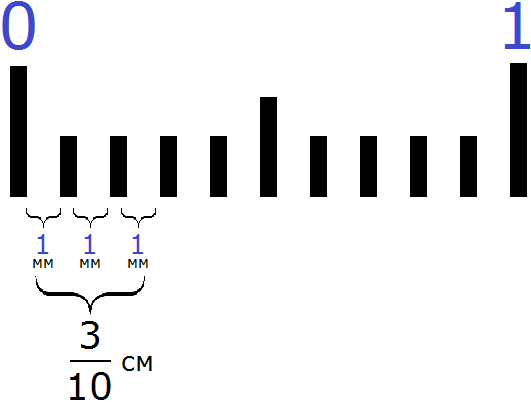Sometimes it is convenient to show something in fractional form. For example, one tenth of a decimeter is written like this:

This expression means that one decimeter was divided into ten equal parts, and one part was taken from those ten parts. And one part of ten in this case is equal to one centimeter:

Consider the following example. Suppose we need to show 6 cm and another 3 mm in centimeters in fractional form.
So we already have 6 whole centimeters:

But there are still 3 millimeters left. How do you show these 3 millimeters in centimeters? Fractions come to the rescue. One centimeter is ten millimeters. Three millimeters is three parts of ten. And three parts of ten are written as ![]() cm
cm

The expression ![]() cm means that one centimeter was divided into ten equal parts, and three parts were taken from these ten parts.
cm means that one centimeter was divided into ten equal parts, and three parts were taken from these ten parts.
The result is six whole centimeters and three tenths of a centimeter:
![]()
The number 6 indicates the number of whole centimeters, and the fraction ![]() indicates the number of fractions. This fraction reads "six whole and three tenths centimeters".
indicates the number of fractions. This fraction reads "six whole and three tenths centimeters".
Fractions with numbers 10, 100, 1000 in the denominator can be written without a denominator. First write the whole part and then the numerator of the fractional part. The whole part is separated from the numerator of the fractional part by a decimal point.
For example, write down ![]() without the denominator. First we write down the whole part. The whole part is 6
without the denominator. First we write down the whole part. The whole part is 6
6
The whole part is written down. Immediately after writing the whole part, put a dot:
6.
And now write down the numerator of the fractional part. In the mixed number ![]() , the numerator of the fractional part is 3. Write a 3 after the decimal point:
, the numerator of the fractional part is 3. Write a 3 after the decimal point:
6.3
Any number that is represented in this form is called a decimals.
Therefore, you can show 6 cm and another 3 mm in centimeters with a decimal:
6.3 cm
It will look like this:

In fact, decimals are the same as regular fractions and mixed numbers. The peculiarity of such fractions is that the denominator of their fractional part contains numbers 10, 100, 1000 or 10000.
Like a mixed number, a decimal has a whole part and a fractional part. For example, in the mixed number ![]() , the whole part is 6 and the fractional part is
, the whole part is 6 and the fractional part is ![]() .
.
In the decimal 6.3, the whole part is the number 6, and the fractional part is the numerator of the fraction ![]() , that is, the number 3.
, that is, the number 3.
It also happens that ordinary fractions with numbers 10, 100, 1000 in the denominator are given without a whole part. For example, the fraction ![]() is given without the whole part. To write such a fraction as a decimal, first write 0, then put a decimal point and write the numerator of the fractional part. The fraction
is given without the whole part. To write such a fraction as a decimal, first write 0, then put a decimal point and write the numerator of the fractional part. The fraction ![]() without the denominator would be written as follows:
without the denominator would be written as follows:
0,5
It reads "zero point five".
2. If you find an error or inaccuracy, please describe it.
3. Positive feedback is welcome.